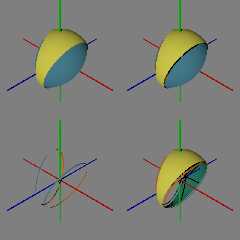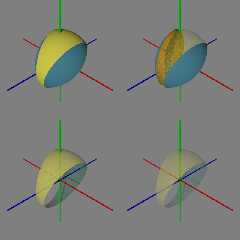|
 |
In the last week plus I've implemented what I think is likely better
bounded_by{} and clipped_by{} implementations when manually bounding /
clipping.
It's been the case, since at least v3.7, that both bounded_by{} and
clipped_by{} accept multiple shapes / objects. For example, we can code:
#declare Iso00 = isosurface {...}
#declare Obj00 = object {
Iso00
bounded_by { sphere { <+0.3,+0.0,+0.0>, 0.25 }
sphere { <-0.3,+0.0,+0.0>, 0.25 }
sphere { <+0.0,+0.3,+0.0>, 0.25 }
sphere { <+0.0,-0.3,+0.0>, 0.25 }
sphere { <+0.0,+0.0,+0.3>, 0.25 }
sphere { <+0.0,+0.0,-0.3>, 0.25 }
}
}
// ----------- or
#declare Iso00 = isosurface {...}
#declare Obj00 = object {
Iso00
bounded_by { sphere { <+0.3,+0.0,+0.0>, 0.25 } }
bounded_by { sphere { <-0.3,+0.0,+0.0>, 0.25 } }
bounded_by { sphere { <+0.0,+0.3,+0.0>, 0.25 } }
bounded_by { sphere { <+0.0,-0.3,+0.0>, 0.25 } }
bounded_by { sphere { <+0.0,+0.0,+0.3>, 0.25 } }
bounded_by { sphere { <+0.0,+0.0,-0.3>, 0.25 } }
// Multiple bounded_by{} blocks parse more slowly than above.
}
I don't believe there is any documentation for this functionality and I
don't recall any, intentional, use of multiple shapes in code I've seen.
A reason is likely that today multiple shape implementations effectively
do an intersection of inside regions and that limits the usefulness - as
do other bounding issues in v3.7/v3.8 fixed in the yuqk fork.
What I'm doing for the next release of yuqk (R20) is adding an optional
'mode' keyword to both bounded_by{} and clipped_by{} which must appear
before the first shape / object.
For bounded_by{} the modes are:
0 : intersection. (Traditional behavior)
ray hits or inside all shapes (POV-Ray v3.7+ default)
1 : union / any.
ray hits or inside at least one of the shapes
For clipped_by{} the modes are:
0 : intersection. (Traditional behavior)
ray->surface intersection inside all shapes
(POV-Ray v3.7+ default)
1 : intersection inverse.
ray->surface intersection outside (0)
2 : any.
ray->surface intersection inside at least one shape
3 : any inverse.
ray->surface intersection outside all shapes
The thought with 'mode 1' of bounded_by{} is that by using multiple
shapes we can sometimes more accurately bound expensive shapes
(isosurface{}s, parameteric{}s, sphere_sweep{}s, etc.) with multiple
simple / fast shapes. In play using multiple sphere{}s to manually bound
cone{}s/cylinder{}s, this idea works(*), but always at a loss in
performance (10-25%) when the target shapes/objects are completely bounded.
(*) - The target shape's solvers run much less and the sphere's code
more, but it looks like where the target is simple, (or the shape itself
has good internal bounding), multiple bounding is likely not a
performance win for the entire shape.
Attaching a couple images and the scene used to generate them. In both
images, starting in the upper left and moving clockwise are: union{},
merge{}, intersection{} and difference{} results from the two
bounded_by{} and clipped_by{} spheres. One showing results with
coincident surfaces and the second where one result is expanded slightly
to eliminate the coincident result.
I find all the results interesting and potentially useful, but we'll
see. I'm new too, to what we might be able to do with the extended features.
Bill P.
Aside:
------
In working on these updates I've run across more checking of the
PATCH_OBJECT type. Reasonably sure I'm going to change patch-like
objects now BASIC_OBJECT types to PATCH_OBJECT. My bet is this change
will make for no functional changes beyond parser checks not allowing
patch-like objects in certain operations where they should probably
never have been allowed - like manual bounding.
Post a reply to this message
Attachments:
Download 'test00.pov.txt' (4 KB)
Download 'bndby_clpby_not_coincident.png' (146 KB)
Download 'bndby_clpby_coincident.png' (184 KB)
Preview of image 'bndby_clpby_not_coincident.png'

Preview of image 'bndby_clpby_coincident.png'

|
 |




![]()